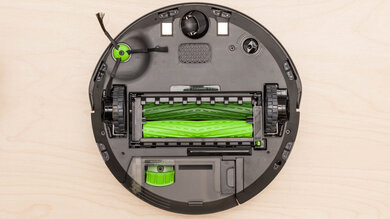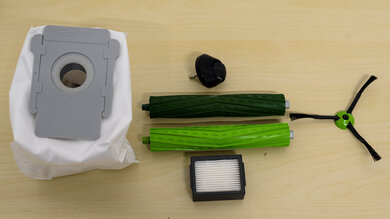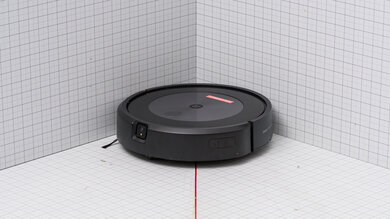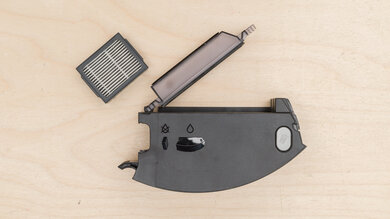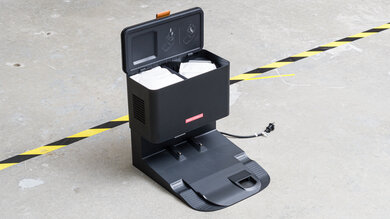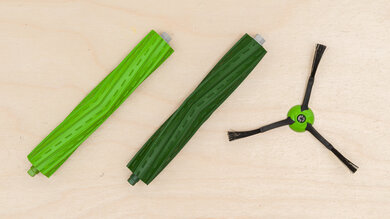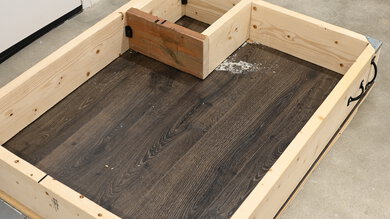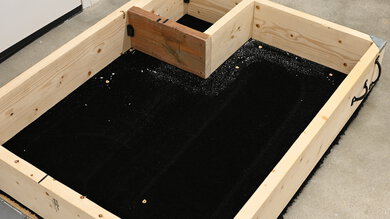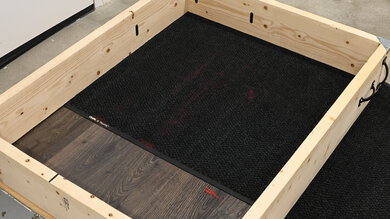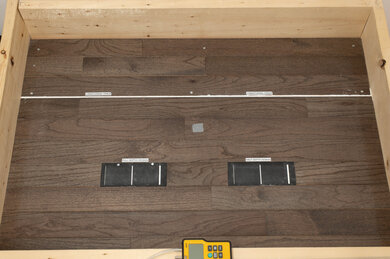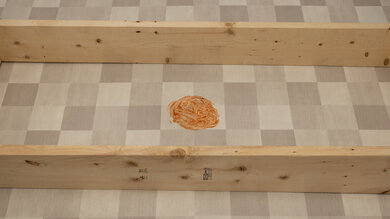The iRobot Roomba j7/j7+ is a premium robot vacuum with advanced automation features. It's positioned below the iRobot Roomba S9, the current flagship of the company's vacuum lineup. It sets itself apart from other iRobot models with its hazard-detection capability, which allows it to identify and avoid hazards like pet waste or electrical cords in real-time. It's also fully compatible with a self-emptying dock, which can be purchased as part of a bundle as the j7+ model variant or individually. It can automatically adjust its head height depending on the surface type that it's on and is advertised as being able to learn your schedule and organize its cleaning sessions around it.
Our Verdict
The iRobot j7 is a reasonable choice for a multi-surface household. It delivers good performance on hard floors and decent performance on carpet, leaving some fine material along walls and in corners. Its two rubber-vaned brushrolls do a satisfactory job on pet hair, though they don't work well removing pet hair embedded in carpet fibers. The obstacle handling is impressive; it cleans in an organized pattern and uses its camera-based object avoidance system to effectively avoid and clean around almost every obstacle it might encounter. The auto-emptying station handles its tasks well but lacks any mopping maintenance capability because the j7 isn't equipped for mopping. This vacuum can't clean stains because of this.
Highly effective obstacle avoidance system.
Good debris pickup on hard floors.
Does well with bulkier debris on carpets.
Struggles with fine debris on carpets.
Struggles with pet hair embedded in high-pile carpets.
- No mopping capability.
The iRobot j7 is an okay option for pet owners. It has no trouble cleaning up pet hair on bare floors and performs decently on low-pile carpets. Its exhaust filter does a good job of trapping allergens as it cleans, and the manufacturer advertises its camera system as being able to identify pet waste and consequently allow the vacuum to maneuver around it. You can also remove its brushrolls for easier cleaning of tangled hair. It's very quiet, too, which is great if your pet is sensitive to loud noise, but unfortunately, it doesn't have a mopping feature that would allow it to scrub away dried-on dirt and debris.
- Advanced automation capabilities.
- Excellent build quality.
Relatively simple design.
Struggles with pet hair embedded in high-pile carpets.
- No mopping capability.
- High recurring costs.
The iRobot j7 delivers good overall debris pickup performance on hard flooring. It clears away a variety of solid debris, ranging from bulky to fine material, within a single cleaning job. However, its side brush can fling some lighter debris outwards, which you'll have to clean up later.
Good debris pickup on hard floors.
The iRobot j7 does a decent job of handling messes on carpeted floors. It's very effective in dealing with medium-sized and bulky debris, though another pass might be necessary to clear away large amounts of fine debris that have accumulated in corners and along walls.
Does well with bulkier debris on carpets.
Struggles with fine debris on carpets.
The iRobot j7 performs satisfactorily when it comes to dealing with pet hair on hard-to-clean surfaces like carpet. It won't struggle with strands of hair left atop carpet fibers, but it does struggle a little bit with shorter hairs that have been pressed deeper into carpet fibers.
Clears loose pet hair sitting on top of carpets.
Struggles with pet hair embedded in high-pile carpets.
The iRobot j7 does a great job of adapting to obstacles. It's quite effective in cleaning up close to most pieces of furniture without getting stuck. While its camera-based navigation system isn't particularly fast when it comes to mapping, it ultimately paints a pretty accurate picture of its coverage area. Similarly, its camera-based hazard recognition system is both accurate and reliable, so you can run it in cluttered rooms without having to worry about it getting stuck.
- Excellent maneuverability.
Highly effective obstacle avoidance system.
- Slow room mapping.
Performance Usages
Changelog
-
Updated Jul 17, 2025:
We added new types of obstacle avoidance technology to the Obstacle Avoidance test box.
-
Updated Apr 16, 2025:
We've added text to this review for the new tests added in Test Bench 1.0.
- Updated Apr 16, 2025: We've converted this review to Test Bench 1.0, which updates our performance testing to include new tests to evaluate Obstacle Adaptability, Obstacle Avoidance, Height Clearance, and Threshold Clearance. We've also introduced new performance usages. For more information, see our changelog.
- Updated Aug 26, 2024: We've updated the scores in the Hard Floor Pick-Up, High-Pile Carpet Pick-Up, Low-Pile Carpet Pick-Up, and Pet-Hair Pick-Up tests to align with a broader data set. For more information about the reasoning for this update, you can look at our forum post.
Check Price
Differences Between Sizes And Variants
The iRobot j7 can be purchased with or without the external dirt bin, with the former variant being referred to as the j7+. Regardless of your model, the j7 and j7+ vacuums are mechanically identical. You can also buy a basic j7 and purchase the self-emptying base station later. Regardless, both models should deliver similar overall cleaning performance, though including the auto-empty dock does reduce hands-on maintenance requirements. We tested the pricier variant with the self-emptying feature and corresponding external dustbin, and you can see its label here.
If someone comes across a differently-equipped iRobot j7, let us know in the discussions, and we'll update our review.
Popular Robot Vacuum Comparisons
The iRobot j7 is a premium robot vacuum with a unique obstruction identification capability. Like the i3+ variant of the iRobot Roomba i3 and the i7+ variant of the iRobot Roomba i7, the j7+ variant of this vacuum is capable of dumping any accumulated debris in its internal dustbin into an external dirtbag mounted to its charging dock. It also has many advanced automation features and feels amazingly well-built. Unfortunately, its performance on low-pile carpet and bare floors is notably inferior to older models.
If you're looking for alternatives, look at our list of recommendations for the best robot vacuums, the best robotic vacuums for hardwood floors, and the best robot vacuums for pet hair.
The iRobot Roomba j9+ is essentially an upgraded version of the iRobot Roomba j7+ but with a few added quirks. It has a higher-capacity battery that allows it to run longer on a single charge, but at the cost of a slower charging time and a slightly more powerful motor. Only the j9 features a Dirt Detective system that allows it to identify and prioritize cleaning areas that see heavy soiling, but this feature is a little buggy, frequently throttling suction to save power, even when an area could use more cleaning.
The iRobot Roomba i7 and the iRobot Roomba j7+ each have advantages, meaning one may suit you better than the other, depending on your needs. The i7 performs significantly better on low-pile carpets and charges faster but has a shorter battery life than the j7+. The j7+ also clears more debris on high-pile carpets and has a unique hazard identification capability to avoid obstructions like pet waste.
The iRobot Roomba j7+ is a better robot vacuum than the eufy E20. The j7+'s performance across almost all floor surfaces is a bit better, and it's a bit quieter than the eufy. Both robot vacuums do a great job with obstacle avoidance, although they take very different approaches. The j7+'s camera-based object avoidance system leaves a large space between the vacuum and the object, also leaving uncleaned areas around obstacles. By contrast, the eufy's LIDAR-based system allows the vacuum to get in very close; it's able to clean more effectively, but occasionally hits objects or gets stuck.
The iRobot Roomba j7+ is better than the iRobot Roomba i3. The j7+ has a longer battery life, maneuvers itself slightly more effectively, can identify and react to hazards in real time, clears more debris on bare floors, and feels slightly better built. The i3 charges faster, however.
Test Results

This vacuum has amazing build quality. Its body is made of high-grade plastic, with a gloss-finish outer casing and glossy top cover. The vacuum's camera sits at the front and features a small LED light to help it see obstructions and hazards. There are a few obvious weak points in the vacuum's construction, and while its internal dustbin could break if you were to drop it, it still feels sturdier than most other robot vacuums' dustbins. Its dock also feels very well-built and even features premium touches like a leatherette pull tab to lift open the external dustbin lid.
The out-of-the-box setup is very easy, with no actual assembly required. You only really need to pair the vacuum with its charging station, and if you buy the j7+ variant, the external dirt compartment comes with a dirtbag already in place.
The j7+ variant of this vacuum has several parts requiring regular maintenance, but thankfully, they're quite easy to access. You can also check the 'Maintenance' tab in its companion app to watch instructional videos for maintaining different components.
- Dustbin: The internal dustbin can be removed by pressing the release button on the side of the vacuum. If there's any leftover debris inside the internal dustbin, you can wipe it out with a dry cloth or tap it against the side of a trash can. If necessary, you can wash it with water, but be sure to remove the filter beforehand. The dirt compartment should dry for 24 hours before you put it back in the vacuum.
- Dirtbag: The dirtbag can simply be pulled out of its housing inside the charging station. It isn't reusable and must be thrown away when it's full, which is indicated by the status light on the docking station switching from white to red. The status light also turns red when the dustbin is blocked, though you also receive an in-app warning when this occurs. A cover on the dirtbag prevents dust and debris from spilling out when removing it. If you purchase the standard j7 model, you won't have to worry about maintaining the self-emptying base station.
- High-Efficiency Exhaust Filter: The filter is located inside the dirt compartment. You can clean it by tapping it against the side of a trash can once or twice a week, depending on your usage habits. You shouldn't wash it with water.
- Brushrolls: The brushrolls can be accessed by lifting the brush guard on the bottom of the vacuum and pulling them out. Depending on your usage habits, you should clean them by removing any hair tangles or debris once or twice a week. Putting them back in place can be difficult since they need to be precisely aligned in their housing.
- Side Brush: The side brush is under the vacuum, and you should clean it of any stuck-on debris once a month.
- Wheel: You can pull the front caster wheel out of the vacuum and then pushed out of its socket. You should clear it of any tangled hair or debris every two weeks.
- Sensors and Charging Contacts: The sensors and charging contacts on the vacuum and docking station should be wiped clean with a dry cloth every two weeks.
The '+' variant of the iRobot j7 incurs very high recurring costs since it has several parts that need regular replacing.
- High-Efficiency Exhaust Filter: You should replace the exhaust filter every two months.
- Rubber Brushrolls: You should replace the brushrolls every six to 12 months.
- Front Wheel: You should replace the front wheel every 12 months, though it isn't currently listed on the manufacturer's website.
- Side Brush: The manufacturer recommends replacing this every three months.
- Dirtbag: You need to throw away and replace the dirtbag when it's full. This won't be a concern if you purchase the vacuum without the self-emptying station.
iRobot sells replacement parts as individual packs, but you can also buy a 'Replenishment Kit' on its website that includes brushrolls, three side brushes, and three exhaust filters.
This vacuum is pretty easy to store. Its base station is designed differently compared to older iRobot models like the iRobot Roomba i3, with a wider and deeper design that's much shorter, so you can fit it under a taller table or under a low-mounted shelf.
The iRobot j7's internal dustbin is quite small, just like other models in the manufacturer's lineup. However, if you go for the '+' variant, which comes with a self-emptying base station, you won't have to empty it yourself. It has an integrated fill sensor, which lets you know when the dustbin or dock station dustbag is full.
The iRobot j7+'s has a docking station with self-emptying capability. It sucks debris from the vacuum's internal dustbin into a 2.4L dirtbag. The manufacturer advertises these bags as being spacious enough to hold 60 days' worth of debris, which aligns with other self-empty stations with similarly sized dustbags. The dock also has a storage slot for an additional dirtbag, so you can quickly swap in a new bag after one has been filled.
- iRobot j7 robot vacuum
- Recharge dock
- Charging cable
- 2x High-efficiency exhaust filters
- Dustbin
- 2x Side brush (one is already fitted to the vacuum)
- 2x Multi-surface rubber brushrolls with bearings
- Getting started guide
The j7+ variant of this vacuum comes with all of these components, along with:
- Self-emptying station (replaces standard charging dock)
- 2x Dirtbags
The iRobot j7 has strong overall battery performance. It can run for more than 100 minutes on a single charge, and since there are no dedicated power modes, you shouldn't see too significant a deviation from that in the real world. While it takes notably longer to recharge than the iRobot Roomba i7, it does have longer battery life. The indicator light under the clean button changes from white to red as its charge level drops, and you can keep an eye on its precise battery level by checking its companion app. You might want to consider the Roborock Q5 if you're looking for a self-emptying robot vacuum with a much longer maximum battery life and don't mind a slower recharge time.
The iRobot j7's front camera is advertised as being capable of identifying hazards like pet waste or power cables and avoiding them. It also features a headlight to help the camera see in dimmer conditions. Still, you might want to consider an alternative like the Roborock S7 MaxV if you want a vacuum with LIDAR mapping for superior low-light mapping and maneuverability. The iRobot j7 has a surface detection feature and consequently adjusts its head height depending on the floor type that it's on, though you can't adjust this manually. It can also identify areas with a higher concentration of dirt and focus on cleaning those spots.
This vacuum's airflow performance is adequate for a robovac, though certainly nothing special. It falls well short of more premium options like the Roborock S8, or indeed the iRobot Roomba S9, and will have a slightly harder time dealing with large amounts of heavyweight debris.
The iRobot j7 is remarkably quiet. You'll hear what people nearby are saying even when the vacuum is running in its most powerful suction mode.
The iRobot j7 does a good job of adapting to larger obstacles. It's small enough to clean under chairs and tables, and it can clean up close to furniture legs without getting permanently stuck. It also cleans in an organized pattern and immediately returns to its docking station after it's finished with its current task. However, you may need to clean the area around the cable yourself if you want a complete clean. It can also bump into tasseled rugs with some regularity, and may even get stuck.
The iRobot j7+ does an outstanding job of avoiding obstacles, but with a few caveats. Like the iRobot Roomba j9+, its camera-based PrecisionVision hazard identification system is highly consistent and very reliable in spotting hazards, especially on bare floors. It isn't likely to get stuck on hazards like socks or power cables, and while it might nudge larger obstacles like shoes, it exhibits consistent behavior in correctly identifying and avoiding pet waste. Performance degrades slightly on carpets but by a far lesser margin than some other robot vacuums.
With all that being said, the system does cause the vacuum to behave in a very conservative manner, as it does give a lot of these obstacles a very generous berth, to the point where there is a slight loss of coverage around some of them. If your risk tolerance is a little higher and you don't mind your vacuum brushing up against obstacles as it cleans, you could also consider something like the Dreame L10s Ultra.
This vacuum's low-profile design allows it to pass under the vast majority of obstacles. It's a good option if you have any couches or TV stands that sit closer to the ground.
This vacuum does a decent job of crossing thresholds. While it won't mount really high-room thresholds, it won't have too much trouble navigating over the majority of room dividers.
The iRobot j7 is reasonably effective in sealing in fine particles. While there are no specific claims regarding the vacuum's sealing performance, it does come with a high-efficiency filter advertised to trap 99% of dog and cat dander allergens.
The iRobot Roomba j7 has terrible stain-clearing performance. Unlike comparably priced alternatives like the Ecovacs DEEBOT OZMO T8 AIVI, this vacuum doesn't have any sort of mopping capability to help clean dried-on stains with water.
The iRobot j7 has an exceptional range of automation features. Aside from its most obvious self-emptying capability, it's advertised as being capable of recognizing your schedule and organizing its cleaning sessions around it. It's fully compatible with Amazon Alexa and Google Home devices, meaning you can control it with voice commands. Unfortunately, its camera-based navigation system is much slower to map out its coverage area than LIDAR alternatives, like the Roborock S8+/S8.
The iRobot Home app is good. You can access a virtual map of its coverage area with the app. You can then use it to set up virtual boundary markers, place no-go zones, or set up precise cleaning zones. Unfortunately, the interface is somewhat buggy, and it's missing common features found on alternatives, like pin-and-go capability. If you have a compatible Braava Jet M-Series robot mop, the "Imprint Link Technology" feature allows it to start mopping automatically after the iRobot j7 is finished vacuuming.

